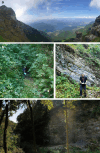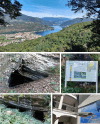Special Issue: 100 years of scientific excavations at UNESCO World Heritage Site Monte San Giorgio and global research on Triassic marine Lagerstätten
- PMID: 39376472
- PMCID: PMC11457694
- DOI: 10.1186/s13358-024-00328-3
Special Issue: 100 years of scientific excavations at UNESCO World Heritage Site Monte San Giorgio and global research on Triassic marine Lagerstätten
Abstract
Only a few Swiss fossil localities are known globally and of which, the UNESCO World Heritage Site Monte San Giorgio, which extends from Switzerland into Italy, is the most important one. Following the discovery of the occurrence of articulated skeletons of marine reptiles in the local mines, large excavations were organized by Bernhard Peyer from the University of Zurich starting 1924. With this collection of articles, we commemorate the successful excavations and research, which initiated the publication of a series of monographies, mostly on the vertebrates but also on the invertebrates of this locality. Especially with the discovery of several remarkably similar Konservat-Lagerstätten in China, the discoveries from Monte San Giorgio gained global relevance. New methodologies such as computed tomography produced a wealth of new data, particularly on endocranial anatomy of several tetrapods.
Keywords: Exceptional preservation; Fishes; Konservat-Lagerstätten; Marine reptiles; Permian–Triassic mass extinction; Taphonomy; Triassic.
© The Author(s) 2024.
Conflict of interest statement
Competing interestsThe authors declare to have no competing interests.
Figures







Similar articles
-
The marine conservation deposits of Monte San Giorgio (Switzerland, Italy): the prototype of Triassic black shale Lagerstätten.Swiss J Palaeontol. 2024;143(1):11. doi: 10.1186/s13358-024-00308-7. Epub 2024 Mar 4. Swiss J Palaeontol. 2024. PMID: 38450287 Free PMC article.
-
Swiss ichthyosaurs: a review.Swiss J Palaeontol. 2024;143(1):31. doi: 10.1186/s13358-024-00327-4. Epub 2024 Sep 1. Swiss J Palaeontol. 2024. PMID: 39229570 Free PMC article.
-
Revision of the Middle Triassic coelacanth Ticinepomis Rieppel 1980 (Actinistia, Latimeriidae) with paleobiological and paleoecological considerations.Swiss J Palaeontol. 2023;142(1):18. doi: 10.1186/s13358-023-00276-4. Epub 2023 Sep 11. Swiss J Palaeontol. 2023. PMID: 37706074 Free PMC article.
-
Thalattosauria in time and space: a review of thalattosaur spatiotemporal occurrences, presumed evolutionary relationships and current ecological hypotheses.Swiss J Palaeontol. 2024;143(1):36. doi: 10.1186/s13358-024-00333-6. Epub 2024 Sep 26. Swiss J Palaeontol. 2024. PMID: 39345254 Free PMC article. Review.
-
The pachypleurosaurids (Reptilia: Nothosauria) from the middle triassic of Monte San Giorgio (Switzerland) with the description of a new species.Philos Trans R Soc Lond B Biol Sci. 1989 Nov 30;325(1230):561-666. doi: 10.1098/rstb.1989.0103. Philos Trans R Soc Lond B Biol Sci. 1989. PMID: 2575768 Review.
References
-
- Airaghi, C. (1911). Ammoniti degli scisti bituminosi di Besano in Lombardia. Bollettino Della Società Geologica Italiana,30, 1048–1050.
-
- Albisetti, D., & Furrer, H. (2023). Bibliografia del Monte San Giorgio (p. 35). Fondazione del Monte San Giorgio.
-
- Arratia, G., Bürgin, T., & Furrer, H. (2024). A new suction feeder and miniature teleosteomorph, Marcopoloichthys mirigioliensis, from the lower Besano Formation (late Anisian) of Monte San Giorgio. Swiss Journal of Palaeontology,143(25), 1–22. 10.1186/s13358-024-00318-5
-
- Bassani, F. (1886). Sui fossili e sull’età degli schisti bituminosi triasici di Besano in Lombardia. Atti Societa Italiana Di Scienze Naturali,29, 15–72.
LinkOut - more resources
Full Text Sources
